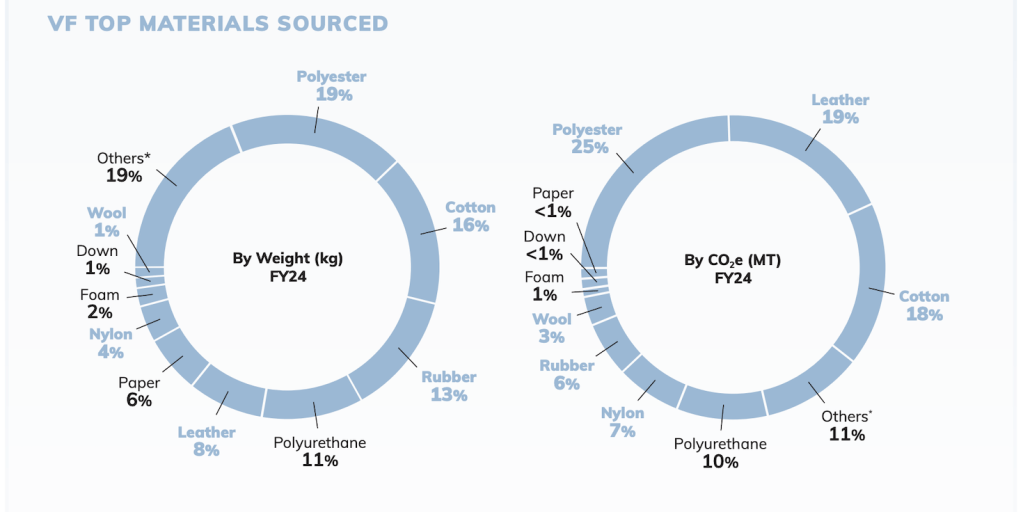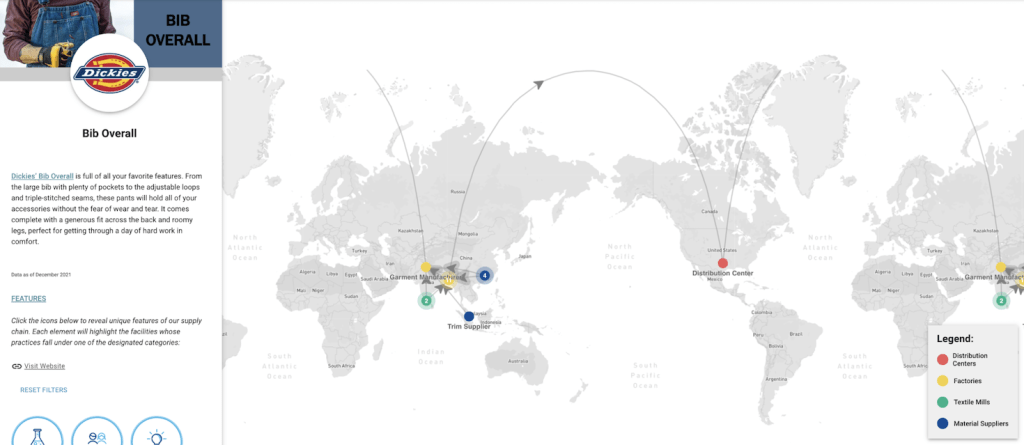VF Corporation hits 61% traceability for key materials
VF Corporation has already mapped the global supply chains of 100 products, including Dickies overalls, Smartwool base layers and The North Face hiking boots. Now, the Denver company reports significant progress toward tracing five key materials down to the commodity level by 2028.
The company disclosed in its Oct. 7 sustainability report that it has achieved 61 percent traceability by volume, the first time it has shared this metric, for certain animal, plant and fossil materials. Wool leads at 78 percent; leather is next at 67 percent. They are followed by natural rubber (56 percent), synthetics and cotton (both 51 percent).
Purchasing more “preferred and regenerative materials” and reducing production volumes helped VF cut Scope 3 emissions by 7 percent in 2024 compared with 2023, though the footprint remains 19 percent above a 2017 baseline.
“We can’t fix what we don’t know, and this work is key to compliance,” said Harsha Chenna, VF’s VP of global product stewardship. Traceability helps meet responsible sourcing policies and regulatory compliance and monitors risks including human rights, water scarcity, deforestation and pollution, he added.

Five key materials
The company said 5,003 metric tons of its five key materials were produced with regenerative practices in 2024. Among the progress it marked for each material in 2025:
- Cotton: VF traced 54 percent across all tiers, aiming to source all of the material from Australia, the U.S. or other regions with sustainable origins by 2026. Regenerative cotton represented 94 percent of the company’s 2024 supply, up from 89 percent the previous year.
- Synthetics: VF traced 56 percent, from Tier 1 to 5. Recycled material accounted for 64 percent in 2024, up from 48 percent in 2023, surpassing its 2026 goal early. Ninety-five percent of polyester and 80 percent of nylon used by The North Face came from preferable sources.
- Leather: VF traced 75 percent from Tiers 2 to 5. Timberland used 78 metric tons of regenerative leather in 2025, and 90 percent of footwear tanneries were Leather Working Group-audited.
- Rubber: VF traced 74 percent of the natural supply chain. The North Face, Timberland and Vans collectively used 319 metric tons of regenerative rubber in 2024.
- Wool: VF traced 87 percent across all tiers and counted 94 percent ZQ-certified wool in 2024.
Traceability history
VF began dedicated traceability work in 2017, piloting material mapping across 10 products. By 2021, it had expanded to 100 products across 1,200 sites. The company seeks to map materials down to the commodity level, relying on data including supplier traceability, country-level risk maps and environmental and social risk metrics.
“Traceability is still very difficult, requiring significant time, resources and analysis,” Chenna said. VF’s teams in North America and Asia-Pacific report directly to him.
VF conducted 1,070 supply chain audits in 2025. It publicly shares addresses and details for 1,214 suppliers via the Open Supply Hub, updating quarterly. Most suppliers are in the Asia-Pacific region, followed by the Americas and Europe.

VF is also advancing circular design, which represent a tiny slice of sales, as is common for apparel companies with branded resale programs. Its The North Face Renewed secondhand brand sold 96,000 items in the U.S. and U.K. last year. New The North Face products, in contrast, sell in the hundreds of millions annually.
Emissions targets, market challenges
Raw materials drive 79 percent of VF’s climate footprint: polyester makes up 25 percent, leather 19 percent and cotton 18 percent.
Validated by the Science-Based Targets initiative, VF aims for net zero by 2050. Near-term goals include cutting Scopes 1 and 2 emissions by 55 percent and Scope 3 emissions by 33 percent by 2030 from a 2017 base. The recent inclusion in the footprint of refrigerants from HVAC systems in 1,127 stores in 2017 complicates year-over-year comparisons of overall emissions.
VF has faced scrutiny from watchdog group Stand.earth for lagging climate progress. The company does not appear on track to lower supply chain emissions by 33 percent by 2030, according to Stand’s Senior Corporate Climate Campaigner Rachel Kitchin. However, she praised VF’s increased use of regenerative cotton, and tracing some materials to Tier 5.
VF’s annual revenues dropped nearly 4 percent to $9.5 billion in 2025. The company’s 2025 sustainability report followed workforce reductions a month earlier, including the departure of Senior Director of Sustainability David Quass. However, the sustainability work continues apace, according to the company.
The post VF Corporation hits 61% traceability for key materials appeared first on Trellis.
